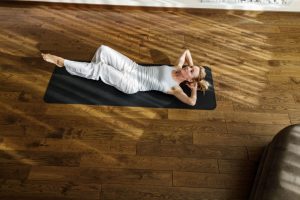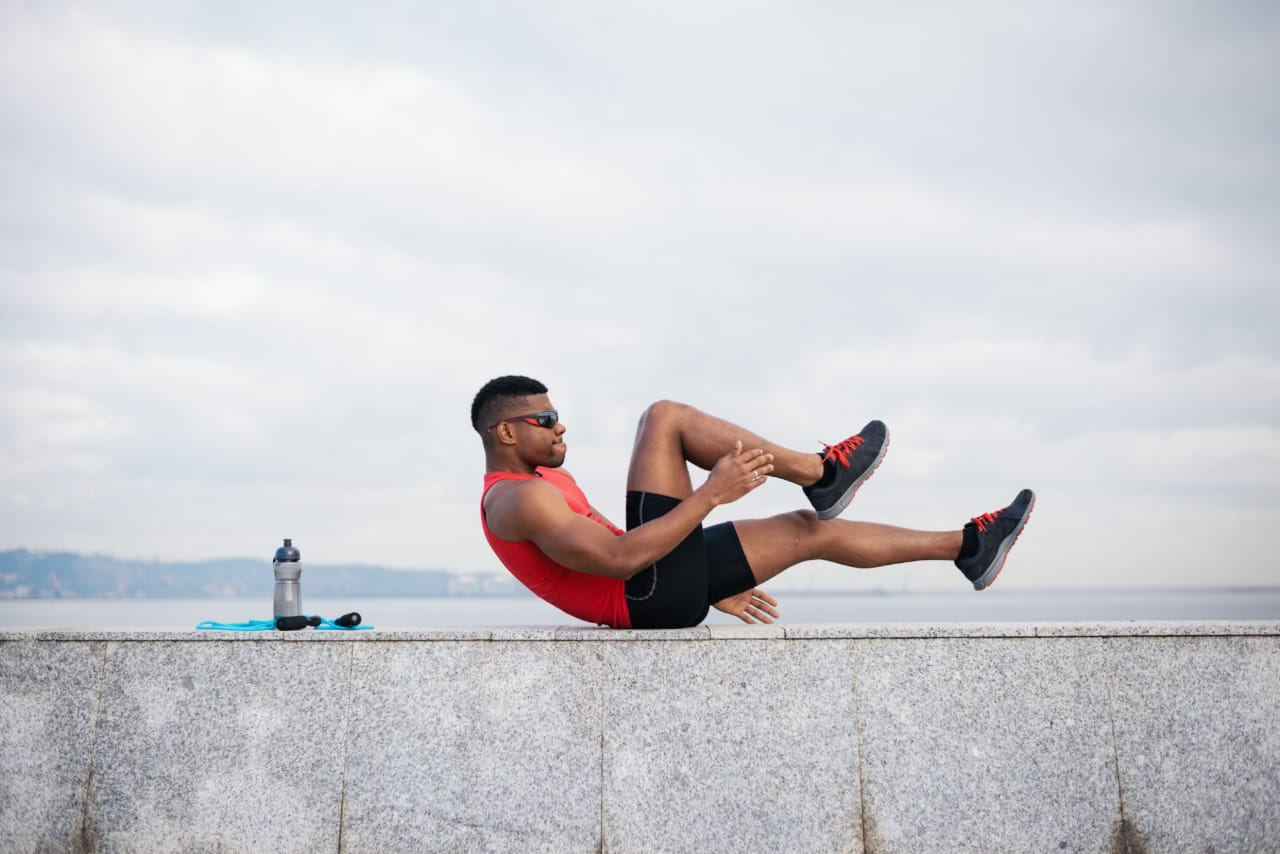How to Do Crunch Kicks Perfectly (Best Guide)
Has working out become a chore instead of a fun experience? Despite your regular workouts, your abs appear to be the same? Perhaps it’s time to try something different. Switch it up to crunch kicks to drastically shift the rhythm of your workout.
Crunch kick is a fun and intense workout that doesn’t require any special equipment. It can be done almost anywhere, either at home, in the gym, or even on vacation in your hotel room. Crunch kicks can be done comfortably while lying flat on the floor.
It is an effective abdominal exercise perfect for beginners.
Let’s have some fun learning about crunch kicks without giving too much away now.
What are Crunch Kicks?
Crunch kicks are a high-intensity bodyweight workout that requires only a flat training mat. For an intense ab workout, all you have to do is lie on the floor, lift your legs in the air and bend your knees as you lie down. Begin extending and moving your knees away from your body before drawing them back in. You will do this a few times per week.
They can be used on their own, as a component of a bigger circuit, or as a highly efficient warm-up for the thighs, core, and hip flexors. They will raise your heart rate, increase blood flow to your muscles, strengthen mobility and flexibility, burn more calories, and aid in muscle tone and control.
They focus on your hip flexors, upper legs, and lower stomach. Although, the entire core will be engaged, with full-functioning balance and reflexes necessary for the workout. It is excellent for core stability and lower ab growth.
What are the Benefits of Building Your Abs?
Building your core abs is vital for a variety of reasons, both functional and practical.
It is your abdominal muscles that shield your organs.
When you flex your ab muscles, you are guarding your organs against any pressure that may be applied to them as a result of an accident or something else. For example, if you’re flexing when you’re punched in the stomach, it doesn’t hurt nearly as much as if you’re not.
Building your abs is the core of your body.
Strong abdominal muscles help us stay upright and enhance our strength and balance.
If your core muscle is firm, it improves any semi-athletic activity you engage in. As a result, professional athletes invest a significant amount of time in strengthening their core muscles.

How to Perform Crunch Kicks
Begin with your lower back and feet resting on the mat. Lift your torso up by raising your shoulders to your hips and contracting your stomach muscles. You will repeat this procedure while keeping your core tight.
Let’s get started with these simple steps below:
Lie down with your arms straight on the mat. Your hands will be somewhat away from the sides of your body but will be on the mat.
While facing the ceiling or sky, gently elevate your shoulders and upper part of your body from the floor.
Lift your legs up while bending your knees.
After that, stretch your knees out from your body.
To finish the workout, bring your knees to the beginning position.
Typically, you will do three different sets of 10 to 12 crunches
.
How to Breathe During Crunch Kicks
When doing crunch kicks, you need to maintain a breathing pattern so as not to get fatigued from the entire process. As you come forward, you exhale and then inhale as you return to the starting position.
How Best Should Crunch Kicks Be Used?
Crunch kicks are a great exercise, but a complete crunch kick routine should also incorporate regular crunches, sit-ups, planks, and lying knee curls. You can achieve a more adequately defined ab and a sustainable solution by combining crunch kicks with higher ab workouts. You will also be able to grow the complete abdominal muscles by incorporating other abs workouts.
Crunch kicks, just like flutter kicks, lying knee curls, and hanging push-ups, only target the lower abs. This makes your upper torso inactive while your lower region is active.
When it comes to ab workouts, there is an essential procedure to be followed:
Upper abs are worked through upper body activities such as sit-ups and crunches.
Lower abs are worked using lower body exercises such as leg lifts and frog kicks.
It’s a great idea to balance lower ab exercises with upper ab exercises like sit-ups and crunches. Suffice to say that you perform activities that require you to keep your lower body still when your upper body exercises.
What is the Focus Area of Crunch Kicks?
Crunch kicks strengthen your lower abdominals, especially the abdominal muscle. This is the muscle between your pelvic bone and your ribs. The rectus abdominis muscle or abdominal muscle allows for trunk flexion and also aids in breathing.
Once it comes to crunches, the oblique muscles and deep core muscles are also engaged, but to a lower amount.
Your thigh muscles are also engaged during the workout. Crunch kicks work on the buttocks (hip muscles) and quadriceps (leg muscles).
Crunch kicks are also used to loosen up these muscles before a run or a more severe leg exercise.
Crunch Kick Styles
Crunch kicks could be exciting and challenging. However, don’t forget that there are numerous crunch variants to choose from.
Twisting Crunches
In this crunch kick style, the obliques, which are on the side of your abdominal muscles, are worked.
Twisting crunches: a step-by-step guide on how it is done.
a. Lie down on your stomach, knees bent, and feet on the floor.
b. Perform a regular crunch by lifting your back and shoulders off the floor.
c. Shift your weight to one side of your body.
d. Return to the beginning posture and perform the action again on the opposite side.
Reversal Crunches
How is a reversal crunch done? How does it work? These might be the questions going on in your mind right now. Well, it’s pretty simple.
The reversal crunch is the total opposite of a standard crunch. This is because your knee is raised to the chest instead of stretching them out.
Reverse crunches: a step-by-step guide on how it is done.
a. Lie down on the floor, arms spread out and hands down.
b. Bend your knees to a 90-degree angle while lifting your legs.
c. Tighten your abs and raise your hips off the mat by bringing your knees up.
d. Hold the position for a few minutes.
e. Return your legs to their original posture.
Tabletop Crunches
This variant of crunch kick is a step up from the regular crunches. It is not difficult, so if you’re in excellent condition, you may attempt to try it.
How to perform tabletop crunches
a. Lie down on the ground.
b. Lift your legs and fold them to form a right angle at the knees. You may shift one foot over if you want to.
c. Hold your head with your hands. Do not attempt to pull.
d. Finish the crunch by lifting your torso toward your knees.
Why you Should Perform Crunch Kicks
It is much more than your abs and core. Below are the significant benefits of doing crunch kicks weekly.
Abdominal toning
Crunch kicks can help you get a six-pack by strengthening your abs and making your journey to a significant body successful. However, please note that a proper diet is essential in toning abdominals. The majority of abs are created in the kitchen. While workouts are good for strengthening and building muscles, they don’t help us lose weight. That is, even if you do all the crunches you want, but you don’t pay attention to your nutrition, you won’t shed any stomach fat.
Your body needs a particular level of body fat percentage for your abs to become visible. The body fat for men is 5–14 per cent, while the body fat for women is 5–19 per cent.
You must have a small to moderate caloric intake to do this. Make sure you’re getting adequate protein. Do some ab-specific exercise and resistance training. Get a minimum of seven hours of sleep each night. Maintain consistency and monitor your progress. Be patient, and you’ll have a six-pack in no time.
Click here https://www.aleanlife.com/category/ripped-abs/ for additional abdominal routines.
Develop your core strength
A strengthened core makes daily activities easier, from bending to picking an object off the floor to stretching for a higher object.
It enhances posture and balance as it minimizes the chance of being injured. It can also aid in the maintenance of a good running style.
Increase your flexibility
Crunch kicks can make you become more flexible. As a sprinter, more agility can help you move more fluidly.
Burn calories
Crunch kicks can help you burn some excess calories if you’re trying to lose weight. After all, isn’t it true that every calorie counts? So you need to burn those calories by doing some crunch kicks.
Increase your heart rate
Crunch kicks are strenuous and will quickly have your heart racing.
Warm-up your muscles
Crunch kicks are a great way to warm up your core, glutes, and thighs. They are also a part of a pre-run warm-up practice.
Frequent Crunch Kicks Mistake to Avoid
When doing crunch kicks, as with any other exercise, good form is key. Breathing is also important. Here are some frequent mistakes to stay away from.
Don’t inhale and exhale in a random manner. When you take your legs in, take a deep breath in and out when you stretch them.
Maintain good form at all times. Slowly perform the exercise so that you can maintain control throughout. Don’t merely go with the flow of your actions.
When completing the kick, make sure your legs are completely straight.
Lift your shoulders off the floor or mat and stretch your arms.
As you raise your knees closer to your face, keep them together.
Ensure your palms rest on the floor while completing the kick.
Before attempting kick crunches, do some simple warm-ups.
Pulling forcefully on the neck to lift the torso off the floor might cause neck pain over time. Don’t do this!
Keep your chin elevated as you lift off the mat to avoid stressing the front neck muscles.
When Should Crunches Be Totally Avoided?
Crunches are one of the most effective workouts for developing our abdominal muscles, but they’re not really for everyone. “This exercise should be avoided by anyone with lower back pain, as well as pregnant women,” Rogers says.
Because our abs and lower back are both part of the core, a set of muscles that function together to hold and strengthen the body’s trunk, crunching requires some lower back muscle. Any unexpected strain on the lumbar area (lower back) can aggravate a disease that already exists. “Safer alternatives to strengthen your core include different leg curls or putting a bouncing ball behind the back muscles for stability.”
Compression of the stomach during pregnancy can reduce blood supply to the heart, causing dizziness and perhaps endangering your baby. Crunches should be avoided entirely throughout and shortly after pregnancy.
To Recap
In all, always start with three sets of 10 to 12 repetitions for each of these crunch kick workouts. It is best to take it carefully, like with any crunches. Take your time. One of the faults that should be avoided is moving on up with the swinging motion from your legs. It is an ab workout, not a swinging exercise, so keep that in mind!
Crunch kicks are not to be confused with kick crunches. You perform the latter while standing up and bringing your foot up with your other hand.
If you don’t diet and maintain a low body fat percentage, you won’t obtain a six-pack.
Crunch kicks are a terrific way for athletes to warm up.
